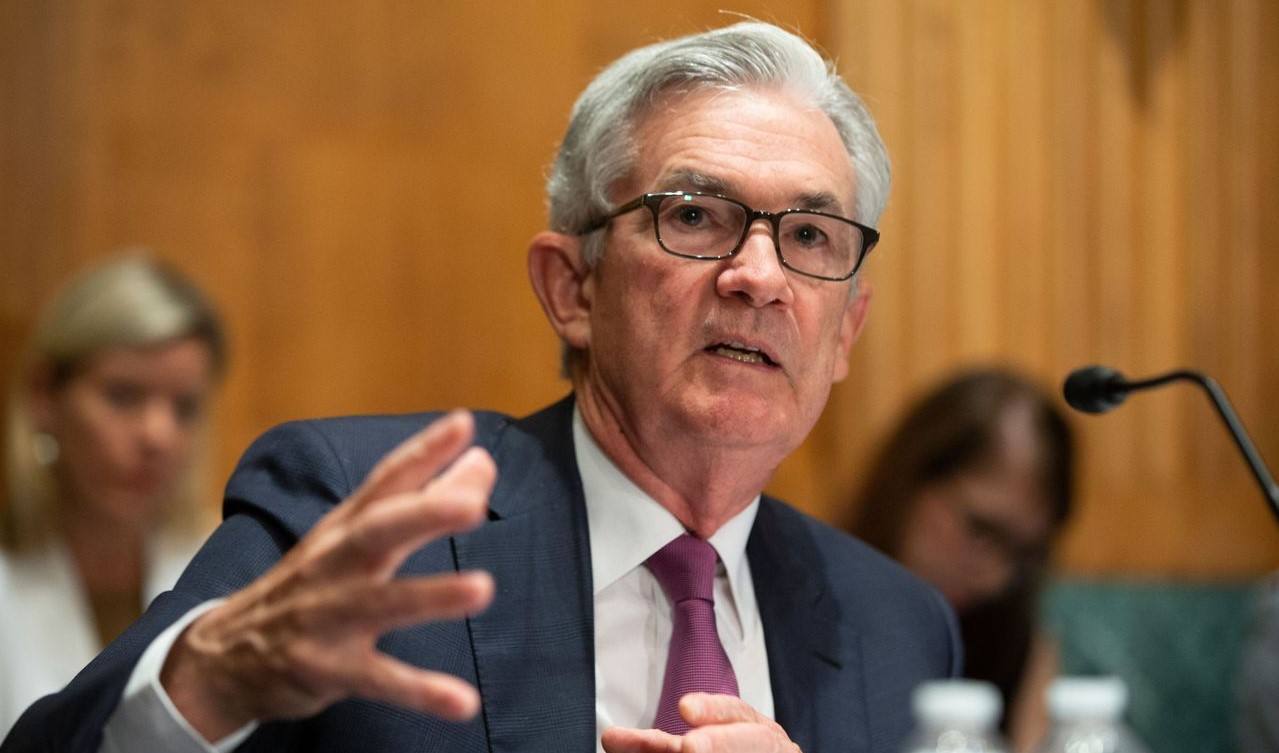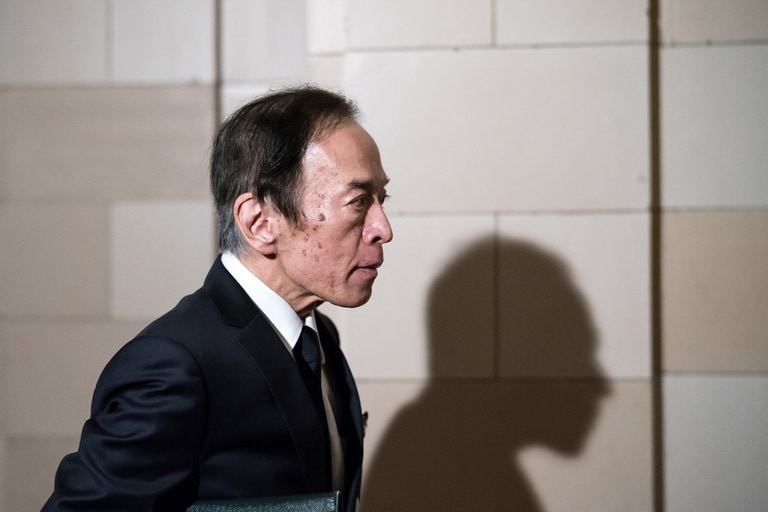Stocks have ripped higher in recent days as investors bet that the US Federal Reserve might soon slow the pace of interest rate hikes. Hopes of a dovish Fed pivot come after markets seemed to lock in 75-basis-point rate hikes for the Fed’s November and December meetings following a hotter-than-expected inflation reading for September. The US consumer price index rose 8.2% in the year to September, down only slightly from August’s 8.3% annual rise.
However, rate-rise expectations shifted on 21 October after a Wall Street Journal article suggested that the Fed could “debate [the] size of future hikes”. Reporter Nick Timiraos wrote that the Fed was planning “another interest-rate rise of 0.75 percentage points at their meeting” on 1-2 November, and “are likely to debate then whether and how to signal plans to approve a smaller increase in December”. His report cited comments made by Fed member Christopher Waller earlier in October about plans for “thoughtful discussion” on the pace of tightening at the November meeting.
Looking for a pivot
So, with the Fed this week poised to raise rates by 75 basis points (bps) for the fourth successive meeting, investors are likely to pay close attention to how the Fed positions itself for the December meeting.
Since that WSJ article was published on 21 October, the S&P 500 has increased by more than 7%. This means that stocks have a lot to give back, especially if the Fed sticks with the status quo and doesn't give the market a dovish signal.
S&P 500, November 2021 - present
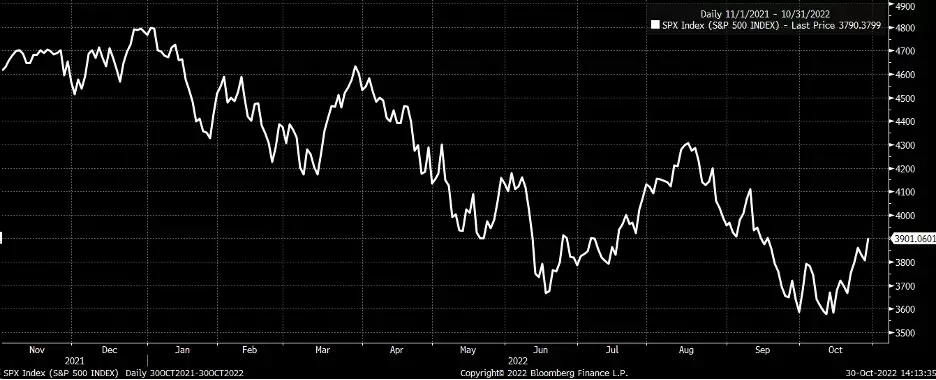
The dollar has also been battered, while bond yields have fallen. A Fed pivot towards smaller rate hikes could send the dollar and yields even lower. However, it seems unlikely that the Fed would signal a policy change at an intra-quarter meeting without the backstop of the summary of economic projections, especially given the strength of the labour market and the overall economy.
Market reaction
The market often behaves oddly on the day of Federal Open Market Committee (FOMC) meetings. This is especially true of equity indexes, which tend to rally post-FOMC. This is because traders tend to buy put options ahead of the meeting to hedge their positions, driving up implied volatility. Once the FOMC press conference begins, implied volatility tends to come out of these put options, making them decay in price. That results in put owners selling their puts, pushing implied volatility down further and stock prices up.
It makes interpreting the post-FOMC decision very difficult, especially when watching stocks, because the rallies are driven by mechanical forces, not a bullish or bearish bias in the market. This makes bonds and the dollar a far more reliable source of information. A rising dollar and rising rates would be indicative of a more hawkish-than-expected Fed. Meanwhile, a dovish Fed would send rates and the dollar lower.
US treasury inflation indexed curve

Fed hawkishness likely to continue
Despite hopes of a pivot, a hawkish Fed still seems more likely than a dovish Fed. The Fed has made it clear that it will raise rates into a restrictive territory and hold them there until they see clear signs that inflation is easing. They have also indicated that they want real yields to be positive across the curve. They have never specified whether they are referring to market-based rates on Treasury inflation-protected securities (TIPS) or nominal rates minus inflation rates.
US personal consumption expenditures price index, excluding food and energy (core PCE), versus US government two-year bonds
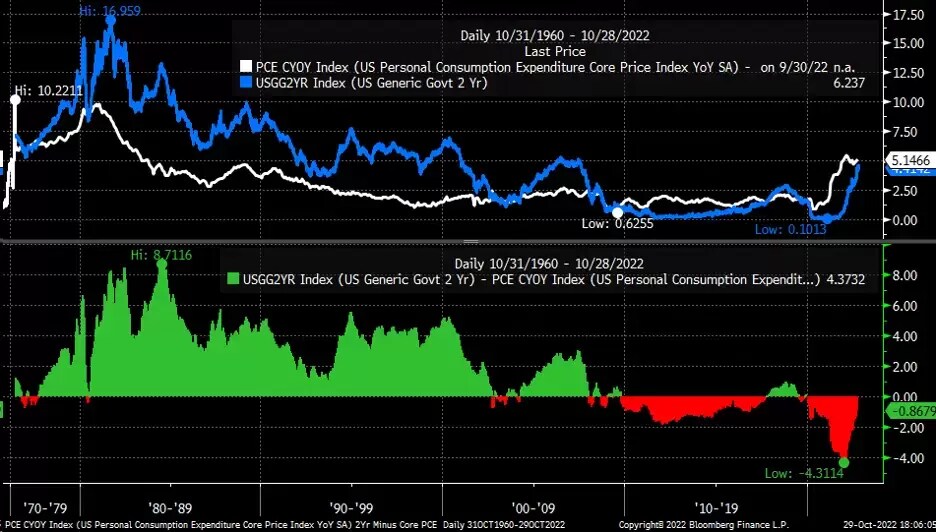
At this point, TIPS rates are all positive, but nominal rates minus inflation rates are not. Since core PCE is currently the lowest of the main measures of inflation at 5.1%, it would suggest that the Fed needs rates to peak above 5.1%. That means the government two-year bond would need to rise by at least another 85 to 90 bps from its current level of 4.40%. Unfortunately for the Fed, inflation may not have peaked. The Cleveland Fed estimates that core PCE will come in at 5.2% for October, higher than September's reading of 5.1%.
Cleveland Fed core PCE forecasts
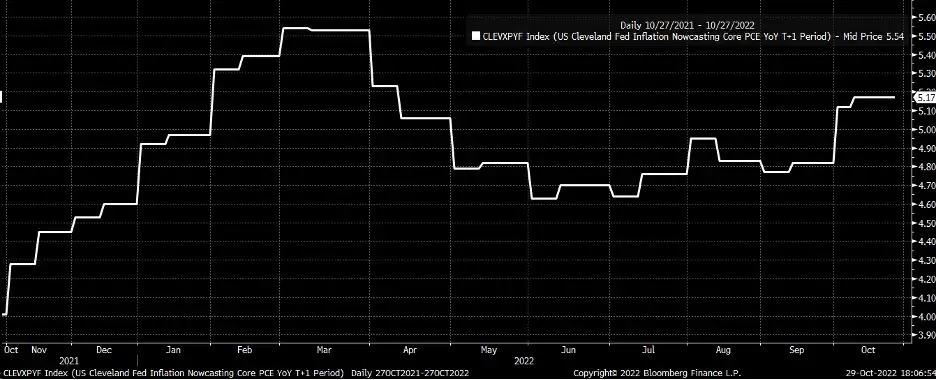
No pivot here
If the Fed signals that further rate hikes of similar size may be warranted at an upcoming meeting, investors may conclude that the economy is heading for a hard landing. But given the available data, that scenario doesn't seem likely. For instance, third quarter nominal GDP growth was at 6.7%. A lot of nominal growth still needs to be taken out of the economy before we get to a hard landing.
If the Fed delivers the status quo at this week's meeting, and the FOMC foresees further rate hikes of a similar size at future meetings, we’ll know that little has changed since Fed chair Jay Powell’s hawkish inflation speech at Jackson Hole in late August. In this scenario, the dollar and rates could rise, while stocks might sink, though not necessarily on the day of the meeting.
Pricing is indicative. Past performance is not a reliable indicator of future results. The author's views and findings are his own and should not be relied upon as the basis of a trading or investment decision.
Disclaimer: CMC Markets Singapore may provide or make available research analysis or reports prepared or issued by entities within the CMC Markets group of companies, located and regulated under the laws in a foreign jurisdictions, in accordance with regulation 32C of the Financial Advisers Regulations. Where such information is issued or promulgated to a person who is not an accredited investor, expert investor or institutional investor, CMC Markets Singapore accepts legal responsibility for the contents of the analysis or report, to the extent required by law. Recipients of such information who are resident in Singapore may contact CMC Markets Singapore on 1800 559 6000 for any matters arising from or in connection with the information.


